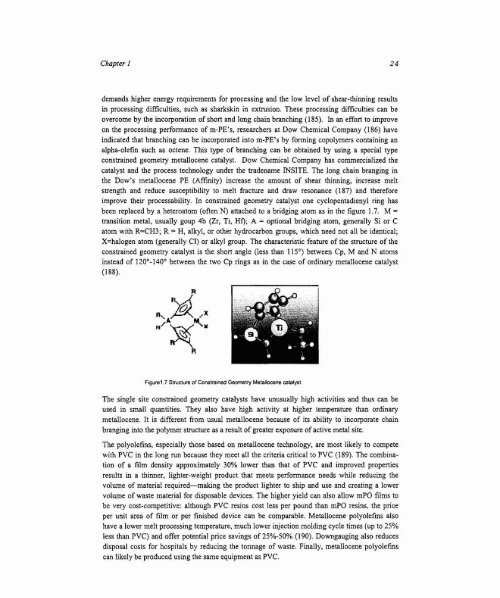Studies on Metallocene Polyolefin and Polyvinyl Chloride for Blood ...
Studies on Metallocene Polyolefin and Polyvinyl Chloride for Blood ...
Studies on Metallocene Polyolefin and Polyvinyl Chloride for Blood ...
Create successful ePaper yourself
Turn your PDF publications into a flip-book with our unique Google optimized e-Paper software.
Chapter 1 24<br />
dem<strong>and</strong>s higher energy requirements <strong>for</strong> processing <strong>and</strong> the low level of shear-thinning results<br />
in processing difficulties, such as sharkskin in extrusi<strong>on</strong>. These processing difficulties can be<br />
overcome by the incorporati<strong>on</strong> of short <strong>and</strong> l<strong>on</strong>g chain branching (185). In an ef<strong>for</strong>t to improve<br />
<strong>on</strong> the processing per<strong>for</strong>mance of m-PE's, researchers at Dow Chemical Company (186) have<br />
indicated that branching can be incorporated into m-PE's by <strong>for</strong>ming copolymers c<strong>on</strong>taining an<br />
alpha-olefin such as octene. This type of branching can be obtained by using a special type<br />
c<strong>on</strong>strained geometry metallocene catalyst. Dow Chemical Company has commercialized the<br />
catalyst <strong>and</strong> the process technology under the tradename INSlTE. The l<strong>on</strong>g chain branging in<br />
the Dew's metallocene PE (Affinity) increase the amount of shear thinning, increase melt<br />
strength <strong>and</strong> reduce susceptibility to melt fracture <strong>and</strong> draw res<strong>on</strong>ance (187) <strong>and</strong> there<strong>for</strong>e<br />
improve their processabiliry. In c<strong>on</strong>strained geometry catalyst <strong>on</strong>e cyclopentadienyl ring has<br />
been replaced by a heteroatom (often N) attached to a bridging atom as in the figure 1.7. M ""<br />
transiti<strong>on</strong> metal. usually goup 4b (Zr, Ti. HO; A = opti<strong>on</strong>al bridging atom, generally Si or C<br />
atom with R"'CH3; R = H, alkyl, or other hydrocarb<strong>on</strong> groups, which need not all be identical;<br />
X=halogen atom (generally Cl) or alkyl group. The characteristic feature of the structure of the<br />
c<strong>on</strong>strained geometry catalyst is the short angle (less than l iS") between Cp. M <strong>and</strong> N atoms<br />
instead of 120"_140" between the two Cp rings as in the case of ordinary metallocene catalyst<br />
(188).<br />
Figure l .7 StrueMe " f C<strong>on</strong>s traIned GeOme1ry Mlltalloeene CllUlyst<br />
The single site c<strong>on</strong>strained geometry catalysts have unusually high activities <strong>and</strong> thus can be<br />
used in small quantities. They also have high activity at higher temperature than ordinary<br />
metallocene. It is different from usual metallocene because of its ability to incorporate chain<br />
branging into the polymer structure as a result ofgreater exposure of active metal site.<br />
The polyolefins, especially those based <strong>on</strong> metallocene technology, are most likely to compete<br />
with PVC in the l<strong>on</strong>g run because they meet all the criteria critical :0 PVC (189). The combinetioo<br />
of a film density approximately 30% lower than that of PVC <strong>and</strong> improved properties<br />
results in a thinner. lighter-weight product that meets per<strong>for</strong>mance needs while reducing the<br />
volume of material required-making the product lighter to ship <strong>and</strong> use <strong>and</strong> creating a lower<br />
volume of waste material <strong>for</strong> disposable devices. The higher yield can also allow mPO films to<br />
be very cost-competitive: although PVC resins cost less per pound than mPO resins, the price<br />
per unit area of film or per finished device can be comparable. <strong>Metallocene</strong> polyolefins also<br />
have a lower melt processing temperature, much lower injecti<strong>on</strong> molding cycle times (up to 25%<br />
less than PVC) <strong>and</strong> offer potential price savings of 25%-50% (190). Downgauging also reduces<br />
disposal costs <strong>for</strong> hospitals by reducing the t<strong>on</strong>nage of waste. Finally, metalloccne polyolefms<br />
can likely be produced using the same equipment as PVC.

















